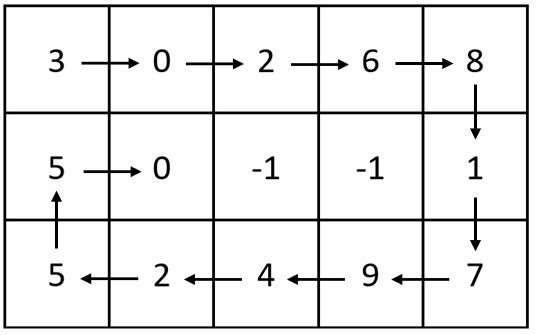Description
You are given two integers m and n, which represent the dimensions of a matrix.
You are also given the head of a linked list of integers.
Generate an m x n matrix that contains the integers in the linked list presented in spiral order (clockwise), starting from the top-left of the matrix. If there are remaining empty spaces, fill them with -1.
Return the generated matrix.
Example 1:

Input: m = 3, n = 5, head = [3,0,2,6,8,1,7,9,4,2,5,5,0] Output: [[3,0,2,6,8],[5,0,-1,-1,1],[5,2,4,9,7]] Explanation: The diagram above shows how the values are printed in the matrix. Note that the remaining spaces in the matrix are filled with -1.
Example 2:

Input: m = 1, n = 4, head = [0,1,2] Output: 0,1,2,-1 Explanation: The diagram above shows how the values are printed from left to right in the matrix. The last space in the matrix is set to -1.
Constraints:
1 <= m, n <= 1051 <= m * n <= 105- The number of nodes in the list is in the range
[1, m * n]. 0 <= Node.val <= 1000
Code
Time Complexity: , Space Complexity:
Reuse the code from Spiral Matrix II.
/**
* Definition for singly-linked list.
* struct ListNode {
* int val;
* ListNode *next;
* ListNode() : val(0), next(nullptr) {}
* ListNode(int x) : val(x), next(nullptr) {}
* ListNode(int x, ListNode *next) : val(x), next(next) {}
* };
*/
class Solution {
public:
vector<vector<int>> spiralMatrix(int m, int n, ListNode* head) {
vector<vector<int>> dir = {{0, 1}, {1, 0}, {0, -1}, {-1, 0}};
vector<vector<int>> answer(m, vector<int>(n, 0));
vector<int> directionalSteps = {n, m - 1};
int dir_idx = 0;
int i = 0, j = -1;
int count = 1;
while(directionalSteps[dir_idx % 2]){
for(int k = 0; k < directionalSteps[dir_idx % 2]; k++) {
i += dir[dir_idx][0];
j += dir[dir_idx][1];
if(head) {
answer[i][j] = head->val;
head = head->next;
} else {
answer[i][j] = -1;
}
}
directionalSteps[dir_idx % 2]--;
dir_idx = (dir_idx + 1) % 4;
}
return answer;
}
};